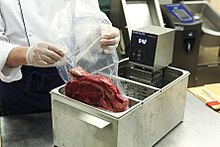| This article needs additional citations for verification. Please help improve this article by adding citations to reliable sources. Unsourced material may be challenged and removed. Find sources: "Thermal immersion circulator" – news · newspapers · books · scholar · JSTOR (September 2018) (Learn how and when to remove this message) |

A thermal immersion circulator is an electrically powered device that circulates and heats a warm fluid kept at an accurate and stable temperature. It is used in process, environmental, microbiological, hazardous waste, and other laboratories. Since 2005 they have also been used for sous-vide food cooking, a method that uses airtight plastic bags in a water bath at accurately regulated temperatures much lower than usually used for cooking.
A thermal immersion circulator comprises a circulator pump or motorized impeller to move the fluid, a heating element immersed in the fluid, an accurate temperature probe, and control circuitry which compares the measured temperature with the desired value and supplies power to the heater as required to stabilize the temperature.
One of the laboratory brands, Huber, states in their user manuals that the laboratory circulators should not be used for food or medical uses. A food-grade, rather than laboratory, circulator is advised for culinary use, even if unused.
References
- "Polyscience – Immersion circulators | Sous Vide Australia". Archived from the original on 2010-09-26. Retrieved 2010-09-26.
- "Getting Started with Sous Vide Cooking - Sous Vide Wizard". Sous Vide Wizard. 2016-04-13. Retrieved 2017-01-25.
- "HUBER: high precision thermoregulation". www.huber-online.com. Retrieved 2017-01-04.
- "Sous Vide FAQ – PolyScience Culinary". Polyscienceculinary.com. 2014-10-13. Archived from the original on 2016-12-02. Retrieved 2016-12-02.